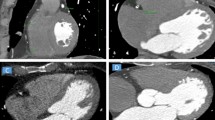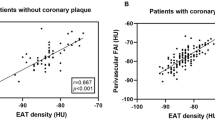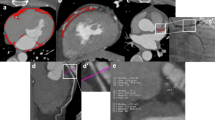Abstract
Introduction
Epicardial adipose tissue may have an important role in the pathogenesis of coronary artery disease (CAD).
Aim
We aimed to study the association between epicardial fat volume (EFV) and presence of obstructive as well as multivessel CAD.
Methods
A total of 87 adult subjects with suspected CAD who underwent both quantified by multidetector computerized tomography (MDCT) and Invasive Coronary Angiography (ICA) were enrolled in this observational study. EVF was measured by MDCT by calculating the sum of cross- sectional areas of fat multiplied by slice thickness. EFV measurement and its association with the presence of obstructive CAD (defined as coronary artery stenosis > 70%) was evaluated.
Results
Overall, 89.6% patients had obstructive CAD with higher EFV as compared to 10.3% patients with non-obstructive CAD (57 ± 20.14 cm3 vs. 44 ± 7.4 cm3; P < 0.001). Furthermore, EFV was significantly increased in group II as compared with group I (74 ± 24.3 ml vs. 53 ± 16.2 ml; P < 0.003). On the hand, the coronary calcium score (CAC) was insignificantly increased in group II as compared with group I (486.1 vs. 211.2; P = 0.10). Multivariate analysis revealed that, EFV might be an independent risk factor for not only the presence of obstructive CAD (odds ratio [OR], 1.062; 95% CI 1.018– 1.108; P < 0.005) but also in predicting multivessel disease affection.
Conclusions
Our results demonstrated that, EFV was significantly increased not only with obstructive CAD, independent of other traditional risk factors and CAC score, but also it can be considered a good predictor of multivessel disease occurrence.



Similar content being viewed by others
Data Availability
Data cannot be shared for confidentiality reasons. Queries about the data should be directed to the corresponding author.“
References
Zheng X, Curtis JP, Hu S, Wang Y, Yang Y, Masoudi FA, et al. Coronary catheterization and percutaneous coronary intervention in China: 10- year results from the China PEACE- retrospective CathPCI study. JAMA Intern Med. 2016;176:512–21. https://doi.org/10.1001/jamainternmed.2016.0166.
Gabriela B, Miksztowicz V, Morales C, Barchuk M. Epicardial adipose tissue in cardiovascular disease. Adv Exp Med Biol. 2019;1127:131–43.
Monti CB, Codari M, de Cecco CN, Secchi F, Sardanelli F, Stillman AE. Novel imaging biomarkers: epicardial adipose tissue evaluation. Br J Radiol. 2020;93:20190770.
Corradi D, Maestri R, Callegari S. The ventricular epicardial fat is related to the myocardial mass in normal, ischemic and hypertrophic hearts. Cardio vasc Pathol. 2004;13(6):313–6.
Moore KL, Persaud TVN. The developing human. Clinically oriented embryology. 7th ed. Philadelphia (PA): WB Saunders; 2003.
Vishal V, Blythe H, Wood EG, Sandhar B, Sarker SJ, Balmforth D, et al. Obesity and diabetes are major risk factors for epicardial adipose tissue inflammation. JCI Insight. 2021;6:16.
McLaughlin T, Schnittger I, Nagy A, Zanley E, Xu Y, Song Y, et al. Relationship between coronary atheroma, epicardial adipose tissue inflammation, and adipocyte differentiation across the human myocardial bridge. J Am Heart Assoc. 2021;10:e021003 [CrossRef].
Gruzdeva OV, Dyleva YA, Belik EV, Sinitsky MY, Stase AN, Kokov AN, et al. Relationship between epicardial and coronary adipose tissue and the expression of adiponectin, leptin, and interleukin 6 in patients with coronary artery disease. J Pers Med. 2022;12:129 [CrossRef].
Sacks HS, Fain JN. Human epicardial adipose tissue: a review. Am Heart J. 2007;153:907–17. https://doi.org/10.1016/j.ahj.2007.03.019.
Sade LE, Eroglu S, Bozbaş H, Ozbiçer S, Hayran M, Haberal A, et al. Relation between epicardial fat thickness and coronary flow reserve in women with chest pain and angiographically normal coronary arteries. Atherosclerosis. 2009;204:580–5.
Sacks HS, Fain JN, Cheema P, Bahouth SW, Garrett E, Wolf RY, et al. Inflammatory genes in epicardial fat contiguous with coronary atherosclerosis in the metabolic syndrome and type2 diabetes: changes associated with pioglitazone. Diabetes Care. 2011;34:730–3.
Ayton SL, Gulsin GS, McCann GP, Moss AJ. Epicardial adipose tissue in obesity-related cardiac dysfunction. Heart. 2022;108:339–44 [CrossRef] [PubMed].
Konwerski MG, Asecka A, Opolski G, Grabowski M, Mazurek T. Role of epicardial adipose tissue in cardiovascular diseases: a review. Biology. 2022;11:355 [CrossRef] [PubMed].
Fitzgibbons TP, Czech MP. Epicardial and perivascular adipose tissues and their influence on cardiovascular disease: basic mechanisms and clinical associations. J Am Heart Assoc. 2014;3:e000582.
Hirata Y, Tabata M, Kurobe H, Motoki T, Akaike M, Nishio C, et al. Coronary atherosclerosis is associated with macrophage polarization in epicardial adipose tissue. J Am Coll Cardiol. 2011;58:248–55.
Paolo Raggi S, Zona R, Scaglioni C, Stentarelli G, Ligabue G, Besutti, et al. Epicardial adipose tissue and coronary artery calcium predict incident myocardial infarction and death in HIV-infected patients. J Cardiovasc Comput Tomogr. 2015;9(6):553–8.
You S, Sun JS, Park SY, Baek Y, Kang DK. Relationship between indexed epicardial fat volume and coronary plaque volume assessed by cardiac multidetector CT. Med. 2016;95(27):e4164.
Iwasaki K, Urabe N, Kitagawa A, Nagao T. The association of epicardial fat volume with coronary characteristics and clinical outcome. Int J Cardiovasc Imaging. 2018;34(2):301–9.
Bettencourt N, Toschke AM, Leite D, Rocha J, Carvalho M, Sampaio F, et al. Epicardial adipose tissue is an independent predictor of coronary atherosclerotic burden. Int J Cardiol. 2012;158:26–32. https://doi.org/10.1016/j.ijcard.2010.12.085.
Guglielmo M, Lin A, Dey D, Baggiano A, Fusini L, Muscogiuri G, Pontone G. Epicardial fat and coronary artery disease: role of cardiac imaging. Atherosclerosis. 2021;321:30–8 [CrossRef].
Ouwens DM, Sell H, Greulich S, Eckel J. The role of epicardial and perivascular adipose tissue in the pathophysiology of cardiovascular disease. J Cell Mol Med. 2010;14:2223–34. https://doi.org/10.1111/j.1582-4934.2010.01141.x.
Talman AH, Psaltis PJ, Cameron JD, Meredith IT, Seneviratne SK, Wong DT. Epicardial adipose tissue: far more than a fat depot. Cardiovasc Diagn Ther. 2014;4:416–29. https://doi.org/10.3978/j.issn.2223-3652.2014.11.05.
Oka T, Yamamoto H, Ohashi N, Kitagawa T, Kunita E, Utsunomiya H, et al. Association between epicardial adipose tissue volume and characteristics of non-calcified plaques assessed by coronary computed tomographic angiography. Int J Cardiol. 2012;161:45–9. https://doi.org/10.1016/j.ijcard.2011.04.021.
Ito T, Suzuki Y, Ehara M, Matsuo H, Teramoto T, Terashima M, et al. Impact of epicardial fat volume on coronary artery disease in symptomatic patients with a zero calcium score. Int J Cardiol. 2013;167:2852–8. https://doi.org/10.1016/j.ijcard.2012.07.026.
Huang G, Wang D, Zeb I, Budoff MJ, Harman SM, Miller V, et al. Intra- thoracic fat, cardiometabolic risk factors, and subclinical cardiovascular disease in healthy, recently menopausal women screened for the Kronos early estrogen prevention study (KEEPS). Atherosclerosis. 2012;221:198–205. https://doi.org/10.1016/j.atherosclerosis.2011.12.004.
Mahaisavariya P, Detrano R, Kang X, Garner D, Vo A, Georgiou D, et al. Quantitation of in vitro coronary artery calcium using ultrafast computed tomography. Cathet Cardiovasc Diagn. 1994;32:387–93. https://doi.org/10.1002/ccd.1810320421.
van Lennep HWOR, Westerveld HT, Zwinderman AH, van Lennep JER, Bruins Slot H, Erkelens DW, et al. Differential effect of female gender on coronary artery disease and peripheral artery disease. Neth Heart J. 2002;10(12):500–5.
Khurana R, Yadav A, Buxi TBS, Sawhney JPS, Rawat KS, Samarjit S, Ghuman. Correlation of epicardial fat quantification with severity of coronary artery disease: a study in indian population. Indian Heart J. 2018;70(Suppl 3):140-S145.
Sinha SK, Thakur R, Jha MJ, Goel A, Kumar V, Kumar A, et al. Epicardial adipose tissue thickness and its association with the presence and severity of coronary artery disease in clinical setting: a cross-sectional observational study. J Clin Med Res. 2016;8:410–9.
Betancur J, Commandeur F, Motlagh M, Sharir T, Einstein AJ, Bokhari S, et al. Deep learning for prediction of obstructive disease from fast myocardial perfusion SPECT: a multicenter study. JACC Cardiovasc Imaging. 2018;11:1654–63. https://doi.org/10.1016/j.jcmg.2018.01.020.
Alexopoulos N, McLean DS, Janik M, Arepalli CD, Stillman AE, Raggi P. Epicardial adipose tissue and coronary artery plaque characteristics. Atherosclerosis. 2010;210:150–4. https://doi.org/10.1016/j.atherosclerosis.2009.11.020.
Rajani R, Haim Shmilovich R, Nakazato R, Nakanishi Y, Otaki VY, Cheng, et al. Features assessed by coronary CT angiography. J Cardiovasc Comput Tomogr. 2013;7(2):125–32.
Aslanabadi N, Salehi R, Tarzamni M, Javadrashid A, et al. Epicardial and pericardial fat volume correlate with the severity of coronary artery stenosis. J Cardiovasc Thorac Res. 2014;6(4):235–9.
Djaberi R, Schuijf JD, van Werkhoven JM. Relation of epicardial adipose tissue to coronary atherosclerosis. Am J Cardiol. 2008;102:1602–7.
Tanami Y, Jinzaki M, Kishi S, Matheson M, Vavere AL, Rochitte CE, et al. Lack of association between epicardial fat volume and extent of coronary artery calcification, severity of coronary artery disease, or presence of myocardial perfusion abnormalities in a diverse, symptomatic patient population: results from the CORE320 multicenter study. Circ Cardiovasc Imaging. 2015;8:e002676.
Cheng VY, Dey D, Tamarappoo B, Nakazato R, Gransar H, Miranda- Peats R, et al. Pericardial fat burden on ECG- gated noncontrast CT in asymptomatic patients who subsequently experience adverse cardiovascular events. JACC Cardiovasc Imaging. 2010;3:352–60. https://doi.org/10.1016/j.jcmg.2009.12.013.
Harada K, Amano T, Uetani T, et al. Cardiac 64-multislice computed tomography reveals increased epicardial fat volume in patients with acute coronary syndrome. Am J Cardiol. 2011;108:1119–23.
Funding
The authors have not received any funding for this clinical study.
Author information
Authors and Affiliations
Corresponding author
Ethics declarations
Conflict of interest
The authors have no conflicts of interest to declare.
Rights and permissions
Springer Nature or its licensor (e.g. a society or other partner) holds exclusive rights to this article under a publishing agreement with the author(s) or other rightsholder(s); author self-archiving of the accepted manuscript version of this article is solely governed by the terms of such publishing agreement and applicable law.
About this article
Cite this article
EL Shahawy, E.S., Hassan, A.A. & EL Shahawy, M.S. Epicardial Fat Volume as a Good Predictor for Multivessel Coronary Artery Disease. High Blood Press Cardiovasc Prev 30, 427–434 (2023). https://doi.org/10.1007/s40292-023-00590-5
Received:
Accepted:
Published:
Issue Date:
DOI: https://doi.org/10.1007/s40292-023-00590-5




